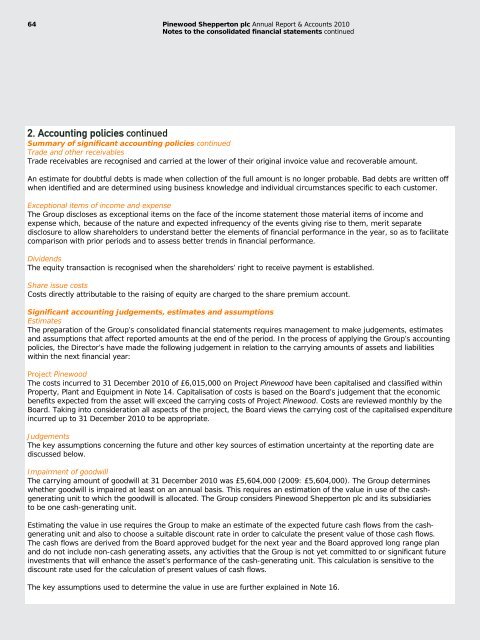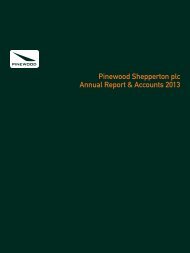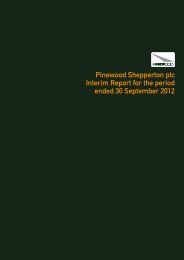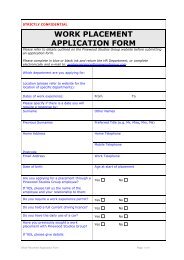Pinewood Shepperton plc Annual Report ... - Pinewood Studios
Pinewood Shepperton plc Annual Report ... - Pinewood Studios
Pinewood Shepperton plc Annual Report ... - Pinewood Studios
- No tags were found...
You also want an ePaper? Increase the reach of your titles
YUMPU automatically turns print PDFs into web optimized ePapers that Google loves.
64 <strong>Pinewood</strong> <strong>Shepperton</strong> <strong>plc</strong> <strong>Annual</strong> <strong>Report</strong> & Accounts 2010Notes to the consolidated financial statements continued2. Accounting policies continuedSummary of significant accounting policies continuedTrade and other receivablesTrade receivables are recognised and carried at the lower of their original invoice value and recoverable amount.An estimate for doubtful debts is made when collection of the full amount is no longer probable. Bad debts are written offwhen identified and are determined using business knowledge and individual circumstances specific to each customer.Exceptional items of income and expenseThe Group discloses as exceptional items on the face of the income statement those material items of income andexpense which, because of the nature and expected infrequency of the events giving rise to them, merit separatedisclosure to allow shareholders to understand better the elements of financial performance in the year, so as to facilitatecomparison with prior periods and to assess better trends in financial performance.DividendsThe equity transaction is recognised when the shareholders’ right to receive payment is established.Share issue costsCosts directly attributable to the raising of equity are charged to the share premium account.Significant accounting judgements, estimates and assumptionsEstimatesThe preparation of the Group’s consolidated financial statements requires management to make judgements, estimatesand assumptions that affect reported amounts at the end of the period. In the process of applying the Group’s accountingpolicies, the Director’s have made the following judgement in relation to the carrying amounts of assets and liabilitieswithin the next financial year:Project <strong>Pinewood</strong>The costs incurred to 31 December 2010 of £6,015,000 on Project <strong>Pinewood</strong> have been capitalised and classified withinProperty, Plant and Equipment in Note 14. Capitalisation of costs is based on the Board’s judgement that the economicbenefits expected from the asset will exceed the carrying costs of Project <strong>Pinewood</strong>. Costs are reviewed monthly by theBoard. Taking into consideration all aspects of the project, the Board views the carrying cost of the capitalised expenditureincurred up to 31 December 2010 to be appropriate.JudgementsThe key assumptions concerning the future and other key sources of estimation uncertainty at the reporting date arediscussed below.Impairment of goodwillThe carrying amount of goodwill at 31 December 2010 was £5,604,000 (2009: £5,604,000). The Group determineswhether goodwill is impaired at least on an annual basis. This requires an estimation of the value in use of the cashgeneratingunit to which the goodwill is allocated. The Group considers <strong>Pinewood</strong> <strong>Shepperton</strong> <strong>plc</strong> and its subsidiariesto be one cash-generating unit.Estimating the value in use requires the Group to make an estimate of the expected future cash flows from the cashgeneratingunit and also to choose a suitable discount rate in order to calculate the present value of those cash flows.The cash flows are derived from the Board approved budget for the next year and the Board approved long range planand do not include non-cash generating assets, any activities that the Group is not yet committed to or significant futureinvestments that will enhance the asset’s performance of the cash-generating unit. This calculation is sensitive to thediscount rate used for the calculation of present values of cash flows.The key assumptions used to determine the value in use are further explained in Note 16.
















